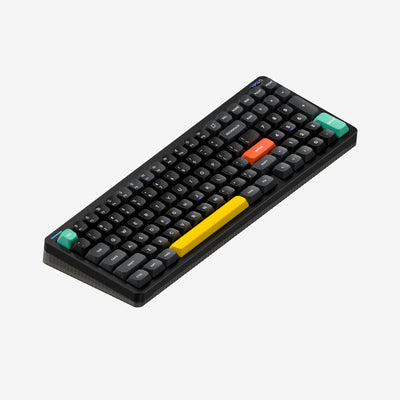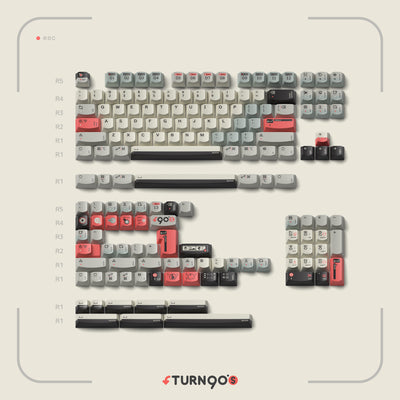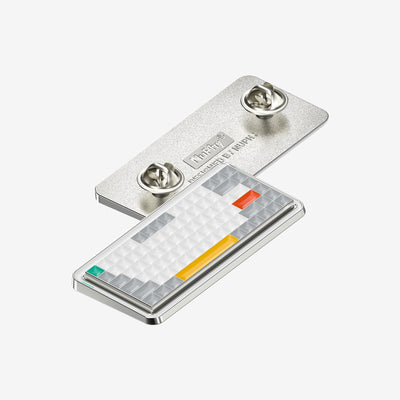Air75 V2
Sep 5th, 2021, I will always remember that day, not as a date on the calendar, but as an entire experience. By that time, the technologically ambitious NuType F1’s development and its lack of a commercial success, have stretched our budgets extremely thin. In fact, the day before I have had sit down with my team to discuss how to properly wind down our company in case our gamble failed-a gamble that our product can find you, that you have as much faith in us as we have in you. Fortunate for us, the moment of truth didn’t arrive much later, Air75’s pre-sale got off to a good start in just a few hours, yet the lingering feeling of surreality, after everything we had gone through, stayed with me for more than half a year.
Air75 is the reason we are here, and the reason that Air60, AIr96, the Halo series, everything NuPhy created are possible. It is a demonstration that hard work on industrial design and UX still pays off, and its many pioneering elements, from the nSA keycaps to the flowing sidelight, the streamlined body and the push feel, made it the best low profile keyboard, and still inspire us today. The size of our team has grown a few times as a result of its success, yet we remain committed to maintain its top position. The following is a record of everything we have done, hardware and software-wise, to make it happen.
Design
Balance is a central theme that we constantly wrestle with when designing, between the old and the new, contrast and uniformity, what is proven and what is disruptive, idealized constructs of the mind and the engineering reality, the answer lies elusive, yet seemingly everywhere. When it comes to a symbolic product like Air75, with so many things we love and spent countless nights on, the challenge only multiplies.
Engineering, in fact, provides part of the answer and illuminate a path in the maze of design possibilities. The remarkable richness and diversity of textures created by the laser texturing process on the plastic bottom case and anodic oxidation process on the aluminum top case, respectively, have inspired us to design intricate patterns and arrangements of the textures to gentle the hard edges of their base materials, and imbue them with a subtle sense of depth, which when enhanced by the anodized and electrophoresed black, gray and white top frame, display an ambience of harmony.
The harmony extends to the relationship between the inside and outside of the keyboard. Old users of Air75 are well informed that the bottom case has always been semi-transparent, serving as a window to its inside workings. On the new Air75 V2, this window is transformed into a nexus connecting the aesthetic to the technical, a gateway where fun merges with function, with the help of good old brute-forcing, the surprising polar opposite of designing. To obtain optimized color hue, saturation and opacity, we built several tens of prototypes to test the perspectives they offer for internal components like the PCB board and battery, with which we did no less experiments to get the colors right-they are intended to match, not simplistically, but to resonate with their case, and to convey extra information subliminally like good designs should do.
The three color themes we decide upon are:
Lunar Gray. Here the engineering plays the biggest part, the traditional cold color is given a touch of coolness.
Ionic White. A new interpretation, as you turn the bottom case towards you the splendor of the interior is unveiled gradually like entering a mist covered forest in the morning.
BIasalt Black. The oldest color is the newest entrant. A deviation from Matte Black’s flatness, vestiges of burnish blue call to mind the stillness under the night’s mantle.
Software/Firmware
During the development phase of Gen1 Air75, we took a feature-oriented approach to software/firmware. They were treated as necessities to enable other exciting aspects of the keyboard, instead of something to stand out on their own. The feedbacks from users, and the progress of our software development capability have led to a shift to a two-horse race approach for Air75 V2’s software solution. The solution utilizing in-house developed firmware, internally labeled ‘B2’ and based on the new MCU disclosed in Air75’s anniversay letter, has reached 90 percent completion as early as the beginning of the year. Focused on the implementation of layers and improved wireless latency and interference resistance, the new firmware was also supposed to support rhythm RGB light and per-key RGB, as well as the long anticipated Mac client.
By the beginning of March, however, it had became clear that the second ‘horse’, the QMK-based solution team, much thanks to the sophisticate Nordic chip their solution is based on, had pulled ahead in wireless performance and stability, and upset our expectations. The surprise was much attributed to the results of the comprehensive wireless benchmarks we have done on QMK wireless keyboards available at the time, which were, without exceptions, dismal. It turns out that such results have far more to do with the subpar hardwares than the potential of QMK-based firmware after all. Meanwhile, the ‘B2’ team started to show difficulties implementing rhythm RGB, which, combined with their lagging behind in the wireless department, had led to the eventual adoption of QMK-based firmware/software on Air75 V2.
Such a decision of course doesn’t come without costs, the extra chip costs, the delayed deadline, etc, could be hard to justify business-wise. They are more than made up for, however, by the improvements in user experiences, which for us occupies a higher priority.
In time, the world's first low profile keyboard combining 1000Hz polling rate 2.4G and QMK firmware, a union of almost infinite customizability and outstanding wired and wireless performance(not to mention the 40% larger battery), has became a reality. Maxing out the stats, however, is not the point. Although software is no longer just an enabler for other features for us, tech as a whole will remain the enabler for better and more flexible user experiences in more scenarios.
AirFeet V3
The magnets fit inside Air75 V1’s foot pads have relocated to NuFolio on Air75 V2, which now holds onto the keyboard through the NuPhy nameplate, remade in stainless iron for its ferromagnetism. The relocation has freed up valuable inner space for the implementation of foldable feet, and provide the following benefits:
- Air75 can now be stabilized on top of almost any laptop keyboard, including MacBooks with M1/M2 chips;
- The foldable feet enables three tilt angles for greater adaptabilities in different environments;
- The keyboard with foldable feet attached can be enclosed inside a NuFolio with ease, making it also possible to use the feet in an outdoor environment;
- The extra space inside NuFolio allows us to put in more magnets, which increases its hold onto the keyboard.
Switches
The high acclaims received by our second generation low profile switches(codenamed KS-33), released with Air96 in cooperation with Gateron, have encouraged us to deepen our involvement in the development of new low profile switches. The multiple obstacles and challenges such an endeavour poses, however, means the development cycle is usually prolonged, and 6 to 12 months have passed before new members of the KS-33 family are ready.
Cowberry is the first silver switch in the KS-33 family, and every bit as silver as you would expect. It sports a extra-length center pole like all of our branded switches, and a short pre-travel of 1.15mm to give you that edge in response, be it shooting or spellcasting. Of course, combine Cowberry with the 1000Hz polling rate Air75 V2 if you want to craft an epic tier manifestation of your in-game prowess.
The second member in the family, Moss, is of an entirely different temper. As the first low profile early bump tactile switch, it took Moss one year to graduate from our ‘incubator’. Our goal at first, to replicate the push feel characteristics of Baby Kangaroo, was quickly abandoned after the structural differences between high and low profile switches made us realize that early bump on a low profile is its own thing. Our second approach, to tweak Wisteria’s design to see how far can we bump up the early bump, and round out the overall feel curve, proved satisfactory, and Moss passed the grad exam with flying colors.
One interesting little detail we would like to share in review of the lineup is if you disassemble one of Aloe, Cowberry, Moss and Wisteria, you would find each of them sporting a distinctive stem pole bottom. This wasn’t by design but dictated by the optimization process when it left no stone unturned. Those visible marks are the residue of a undertaking that in retrospect was a bit too on the paranoid side to the point of irrationality, yet befitting of our characters which for a moment, seemed inseparable from the switches’ characteristics during their creations.
There are many other details, such as the slower expansion Poron pad, and higher expansion ratio PCB IXPE, as well as an extra PET underpad, all play their parts in shaping the switches’ acoustics, the mechanism of which though, would be more fun to explore on your own.
A New Beginning
We believe good designs embody lasting values, and dedicate our company to create them. The diversity of Field75, the simplicity of the Halos, and last but not the least, the frontier mentality of Air75, each serve as a foundation that we can keep building upon, instead of catching on and fizzling equally quickly like many ‘designs’ out there. As our team and supply chain grew bigger and stronger, we have been able to merge more innovative elements into Air75, and break new grounds and boundaries like an Air truly does.





